Investigation of a Novel Consequent-Pole Flux-Intensifying Memory Machine
Abstract
:1. Introduction
2. Machine Topology and Operating Principle
2.1. Machine Topology
2.2. Flux Regulation Principle
2.3. Magnetic Circuit Analysis
2.4. Control Scheme
3. Electromagnetic Performance Investigation of the Proposed CP-FIMM
3.1. Open-Circuit Performance
3.2. Torque Performance
3.3. Flux Regulation Performance
3.4. External Characteristics
3.5. Efficiency
4. Three-Dimensional FE analysis
5. Conclusions
Author Contributions
Funding
Institutional Review Board Statement
Informed Consent Statement
Data Availability Statement
Conflicts of Interest
References
- Wu, L.; Tian, Z. Analysis of a Triple-Stator Axial-Flux Spoke-Type Permanent Magnet Vernier Machine. IEEE Trans. Ind. Appl. 2022. [Google Scholar] [CrossRef]
- Liu, C.; Xu, Y.; Zou, J.; Yu, G.; Zhuo, L. Permanent Magnet Shape Optimization Method for PMSM Air Gap Flux Density Harmonics Reduction. CES Trans. Electr. Mach. Syst. 2021, 5, 284–290. [Google Scholar] [CrossRef]
- Zhao, W.; Yang, Z.; Liu, Y.; Wang, X. Analysis of a Novel Surface-Mounted Permanent Magnet Motor with Hybrid Magnets for Low Cost and Low Torque Pulsation. IEEE Trans. Magn. 2021, 57, 8104804. [Google Scholar] [CrossRef]
- Paul, S.; Chang, J. Fast Model-Based Design of High Performance Permanent Magnet Machine for Next Generation Electric Propulsion for Urban Aerial Vehicle Application. CES Trans. Electr. Mach. Syst. 2021, 5, 143–151. [Google Scholar] [CrossRef]
- Oka, T.; Hasebe, S.; Ogawa, J.; Fukui, S.; Nakano, T.; Yokoyama, K.; Miryala, M.; Sakai, N.; Murakami, M. Magnetizing Technique for Permanent Magnets in IPM Motor Rotors Using HTS Bulk Magnet. IEEE Trans. Appl. Supercond. 2020, 30, 5206304. [Google Scholar] [CrossRef]
- Cheng, M.; Sun, L.; Buja, G.; Song, L. Advanced Electrical Machines and Machine-Based Systems for Electric and Hybrid Vehicles. Energies 2015, 8, 9541–9564. [Google Scholar] [CrossRef] [Green Version]
- Yang, H.; Lin, H.; Zhu, Z.Q.; Lyu, S.; Liu, Y. Design and Analysis of Novel Asymmetric-Stator-Pole Flux Reversal PM Machine. IEEE Trans. Ind. Electron. 2020, 67, 101–114. [Google Scholar] [CrossRef] [Green Version]
- Zhu, X.; Xiang, Z.; Quan, L.; Wu, W.; Du, Y. Multimode Optimization Design Methodology for a Flux-Controllable Stator Permanent Magnet Memory Motor Considering Driving Cycles. IEEE Trans. Ind. Electron. 2018, 65, 5353–5366. [Google Scholar] [CrossRef]
- Limsuwan, N.; Kato, T.; Akatsu, K.; Lorenz, R.D. Design and Evaluation of a Variable-Flux Flux-Intensifying Interior Permanent-Magnet Machine. IEEE Trans. Ind. Appl. 2014, 50, 1015–1024. [Google Scholar] [CrossRef]
- Xu, H.; Li, J.; Chen, J.; Lu, Y.; Ge, M. Analysis of a Hybrid Permanent Magnet Variable-Flux Machine for Electric Vehicle Tractions Considering Magnetizing and Demagnetizing Current. IEEE Trans. Ind. Appl. 2021, 57, 5983–5992. [Google Scholar] [CrossRef]
- Ostovic, V. Memory Motors-a New Class of Controllable Flux PM Machines for a True Wide Speed Operation. In Proceedings of the Industry Applications Conference, 36th IAS Annual Meeting, Chicago, IL, USA, 30 September 2001–4 October 2001; pp. 2577–2584. [Google Scholar]
- Xie, Y.; Ning, Z.; Ma, Z.; Cai, W.; Wei, J. Design and Research of Novel Variable Flux Memory Motor with Series Hybrid Magnets. In Proceedings of the 2020 23rd International Conference on Electrical Machines and Systems (ICEMS), Hamamatsu, Japan, 24–27 November 2020; pp. 2142–2147. [Google Scholar]
- Sun, A.; Li, J.; Qu, R.; Chen, J.; Lu, H. Rotor Design Considerations for a Variable-Flux Flux-Intensifying Interior Permanent Magnet Machine with Improved Torque Quality and Reduced Magnetization Current. In Proceedings of the 2015 IEEE Energy Conversion Congress and Exposition (ECCE), Montreal, QC, Canada, 20–24 September 2005; pp. 784–790. [Google Scholar]
- Lu, Y.; Li, J.; Qu, R.; Sun, A.; Fang, H. A Method to Improve Torque Density and Reduce Magnetization Current in a Variable-Flux Flux-Intensifying Interior Permanent Magnet Machine. In Proceedings of the 2016 IEEE Vehicle Power and Propulsion Conference (VPPC), Hangzhou, China, 17–20 October 2016. [Google Scholar]
- Ibrahim, M.; Masisi, L.; Pillay, P. Design of Variable-Flux Permanent-Magnet Machines Using Alnico Magnets. IEEE Trans. Ind. Appl. 2015, 51, 4482–4491. [Google Scholar] [CrossRef]
- Qiao, G.; Liu, Y.; Zheng, P.; Chen, J.; Zhang, S.; Wang, M. Analysis of Magnetic Properties of AlNiCo and Methods of Mitigating Dynamic Voltage Limits in the Combined-Magnetic-Pole Memory Motor. In Proceedings of the 21st International Conference on Electrical Machines and Systems (ICEMS), Jeju, Korea, 7–10 October 2018; pp. 1175–1180. [Google Scholar]
- Wei, F.; Zhu, Z.Q.; Sun, X.; Yan, L.; Qi, J. Investigation of Asymmetric Consequent-Pole Hybrid Excited Flux Reversal Machines. IEEE Trans. Ind. Appl. 2022, 58, 3434–3446. [Google Scholar] [CrossRef]
- Yang, H.; Lin, H.; Li, H.; Lyu, S. Analysis of Consequent-Pole Flux Reversal Permanent Magnet Machine with Biased Flux Modulation Theory. IEEE Trans. Ind. Electron. 2020, 67, 2107–2121. [Google Scholar] [CrossRef] [Green Version]
- Qi, J.; Zhu, Z.Q.; Li, Y.; Jewell, G.W.; Hilton, C. Effect of Pole Shaping on Torque Characteristics of Consequent Pole PM Machines. In Proceedings of the IEEE International Electric Machines & Drives Conference (IEMDC), Hartford, CT, USA, 17–20 May 2021. [Google Scholar]
- Zhu, X.; Yang, S.; Du, Y.; Xiang, Z.; Xu, L. Electromagnetic Performance Analysis and Verification of a New Flux-Intensifying Permanent Magnet Brushless Motor with Two-Layer Segmented Permanent Magnets. IEEE Trans. Magn. 2016, 52, 8204004. [Google Scholar] [CrossRef]
- Ngo, D.; Hsieh, M.; Huynh, T.A. Torque Enhancement for a Novel Flux Intensifying PMa-SynRM Using Surface-Inset Permanent Magnet. IEEE Trans. Magn. 2019, 55, 8106108. [Google Scholar] [CrossRef]
- Liu, F.; Quan, L.; Zhu, X.; Xiang, Z.; Wu, W. Investigation of Reverse Saliency Characteristic in Flux-Intensifying Hybrid Permanent Magnet Motor Considering Various Operation Conditions. In Proceedings of the 2018 IEEE International Conference on Applied Superconductivity and Electromagnetic Devices (ASEMD), Tianjin, China, 15–18 April 2018; pp. 1–2. [Google Scholar]
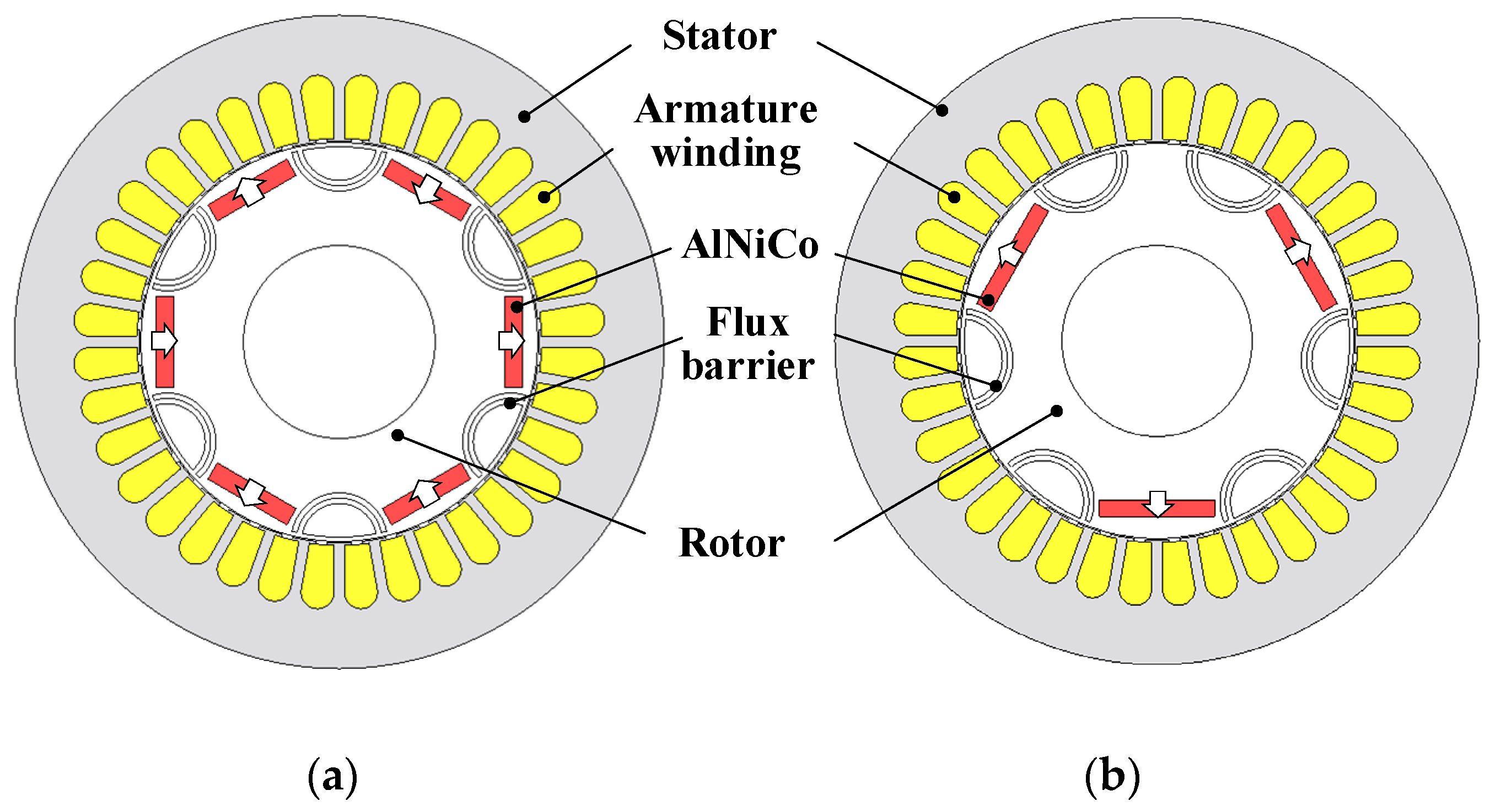
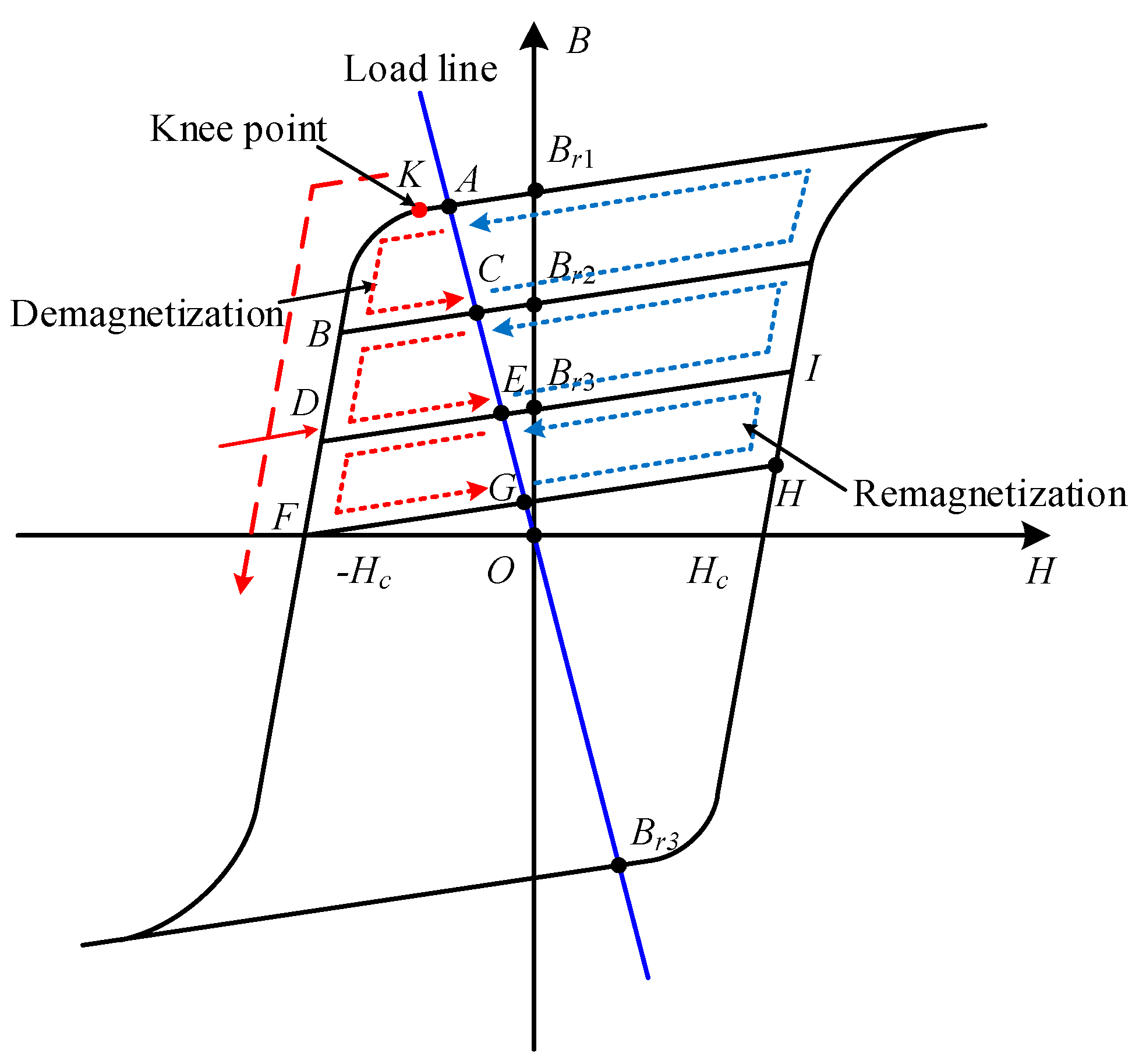
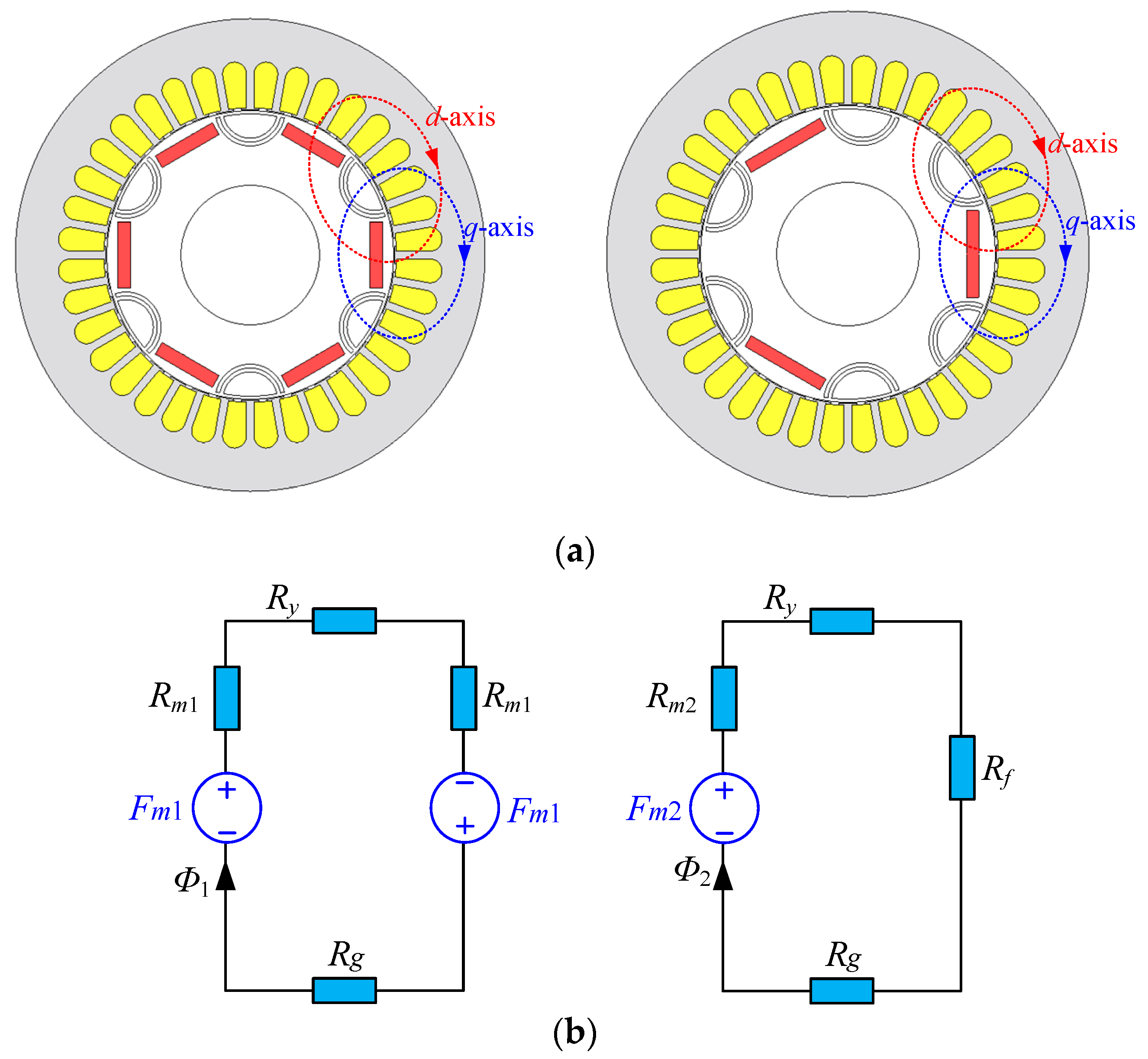
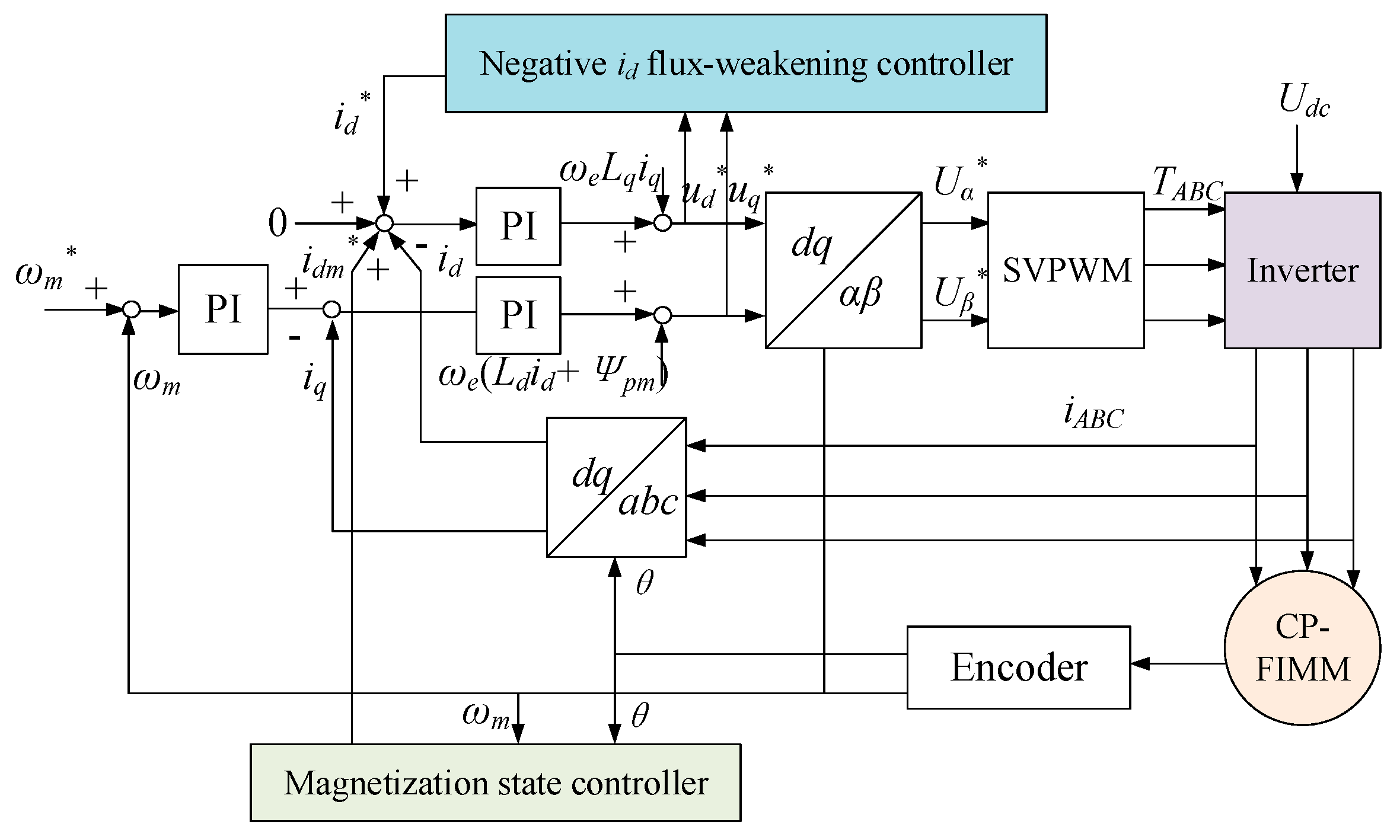

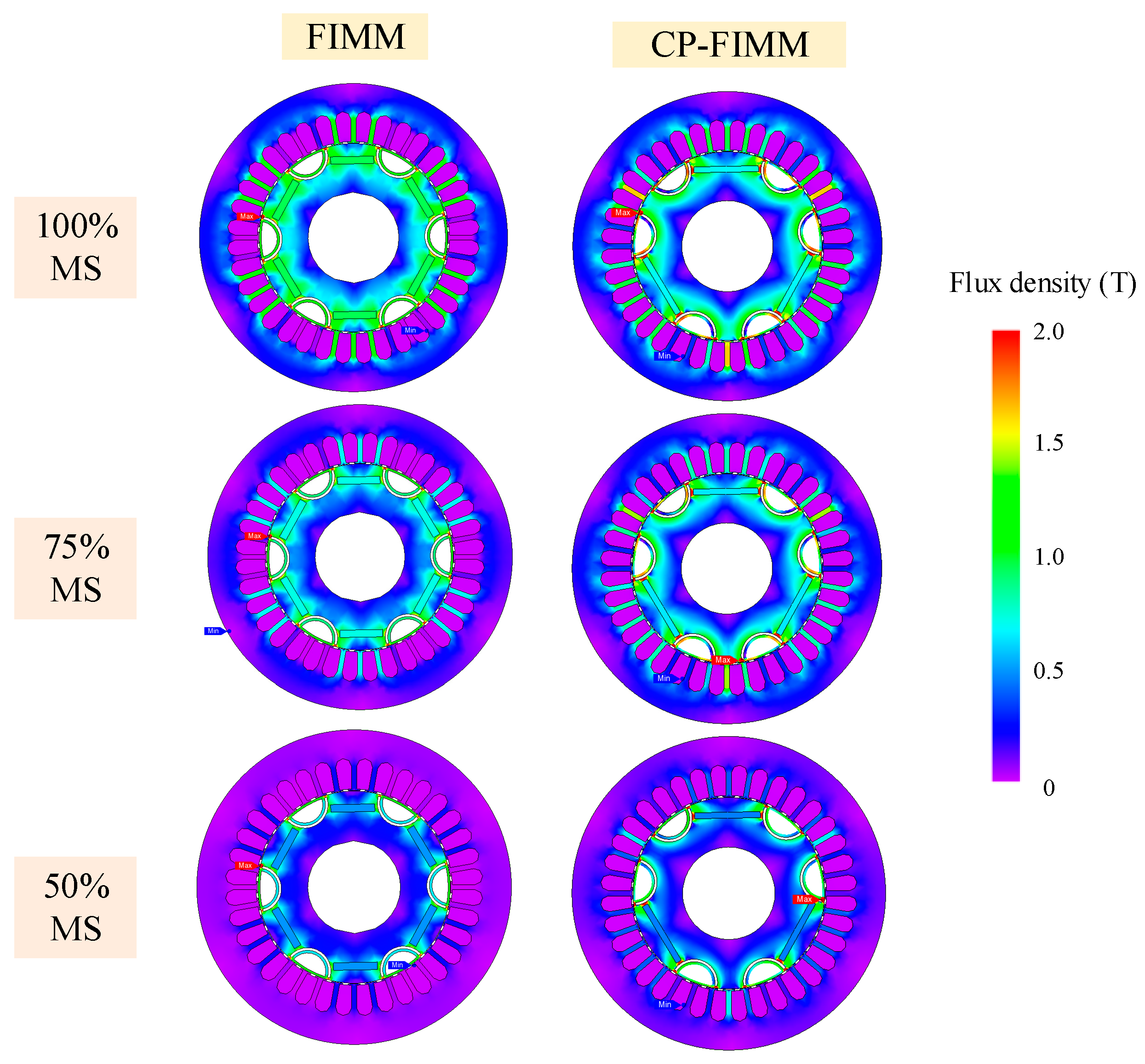
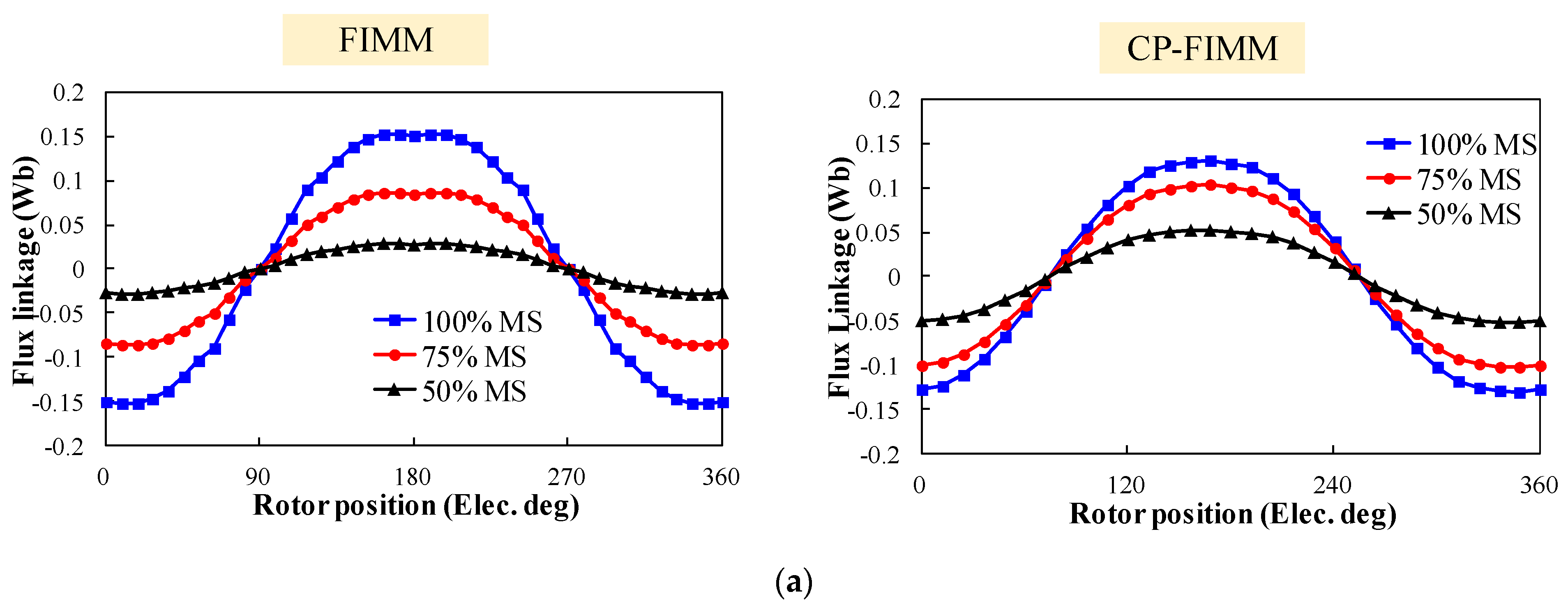

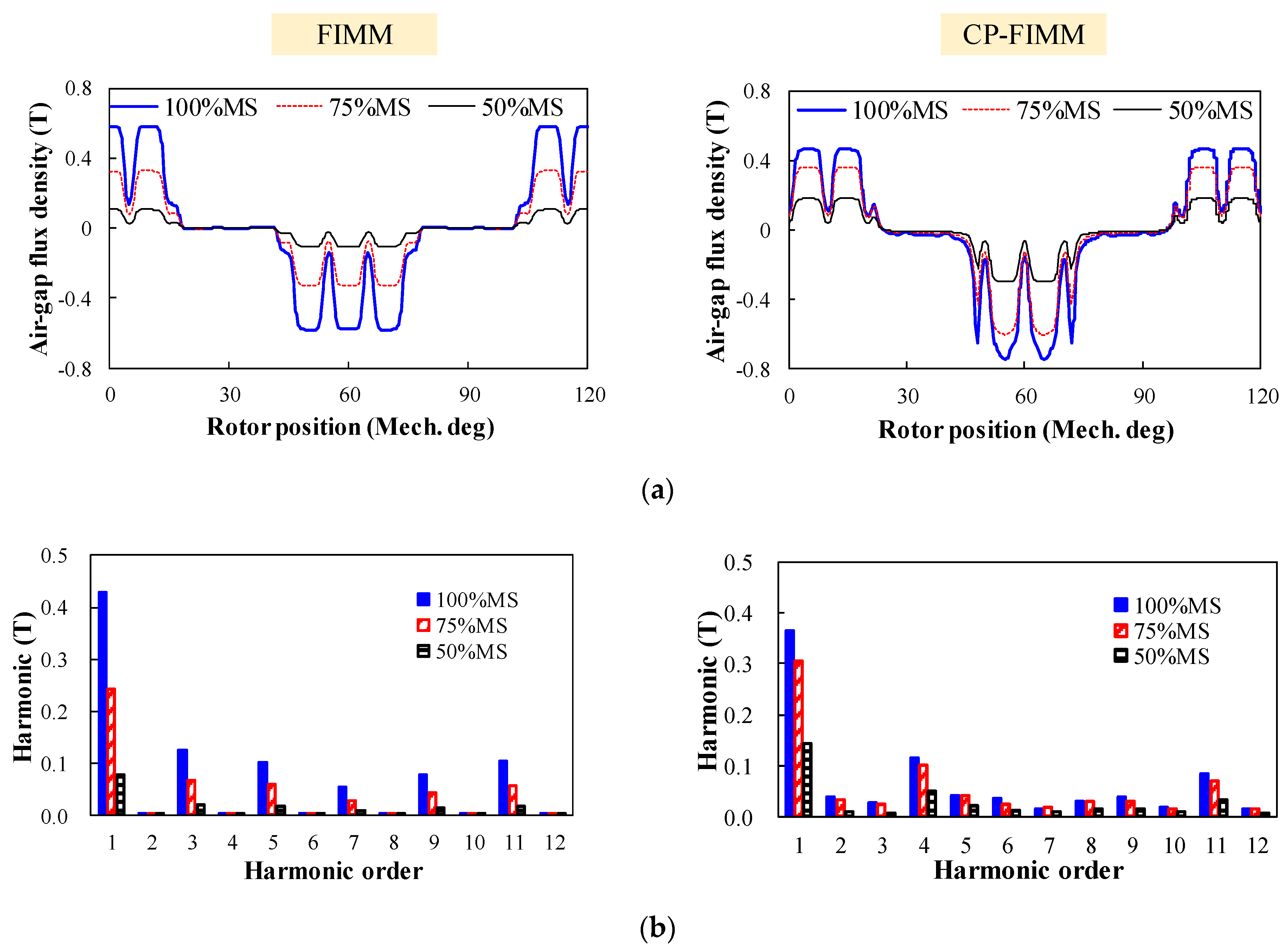
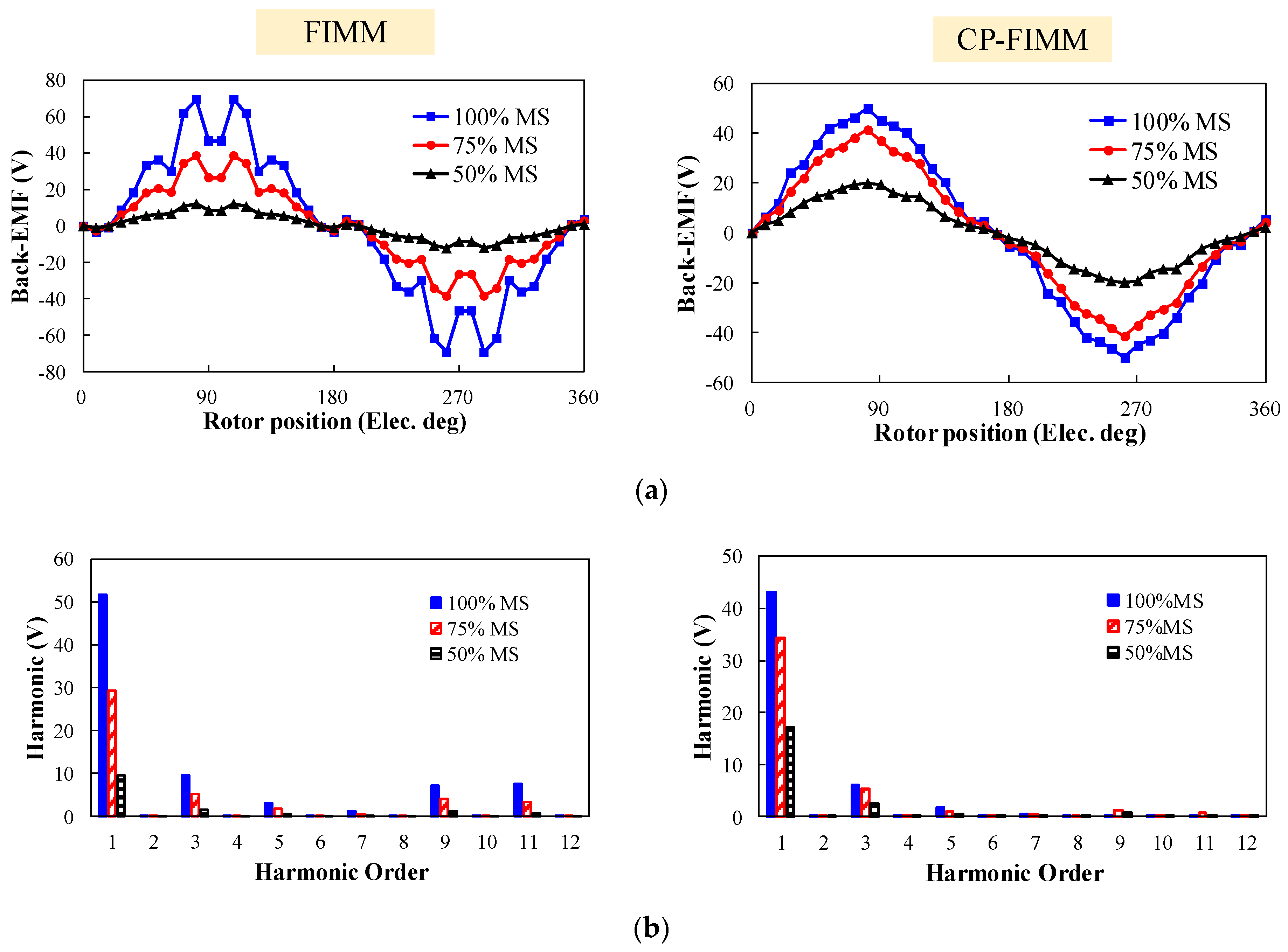
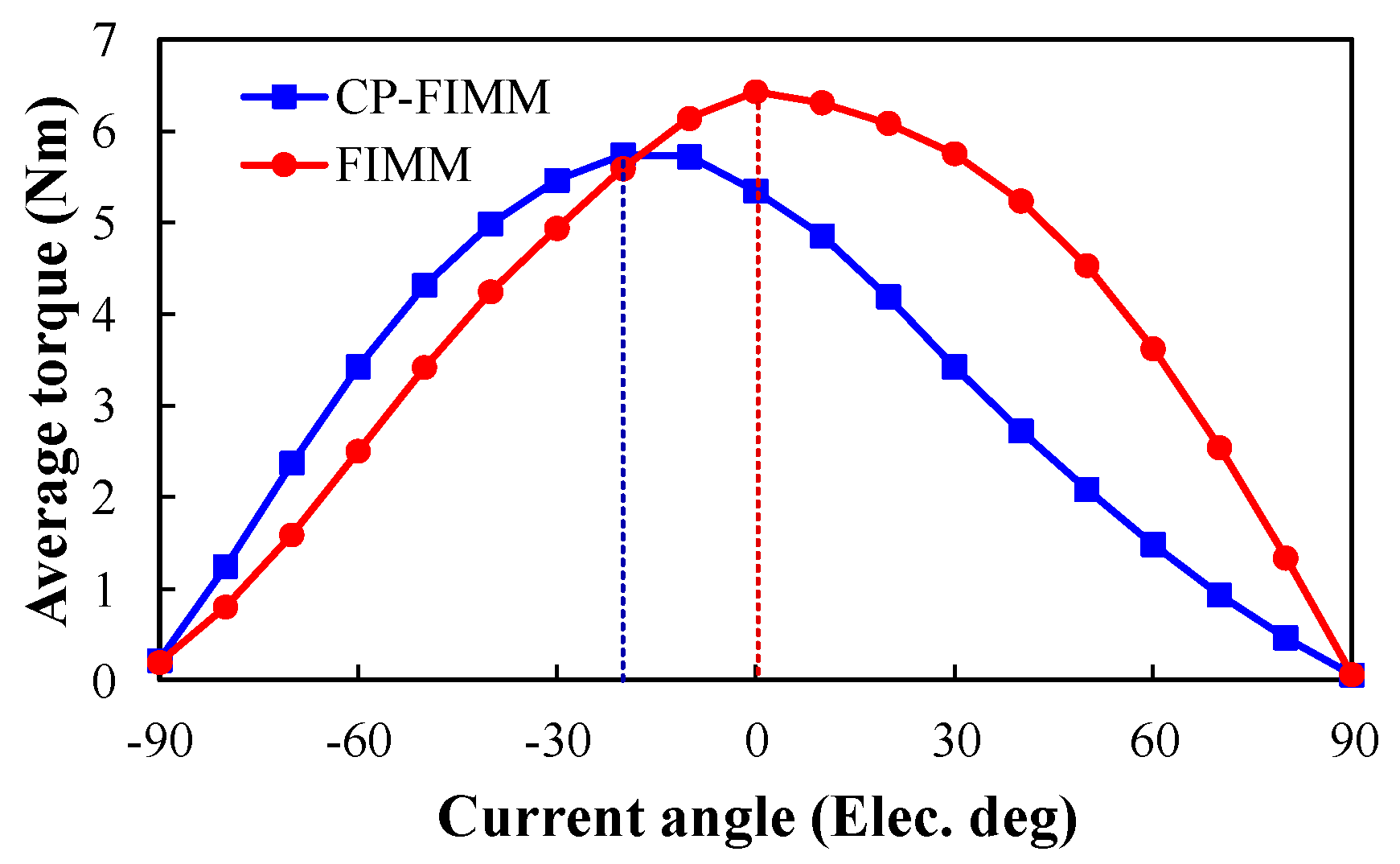


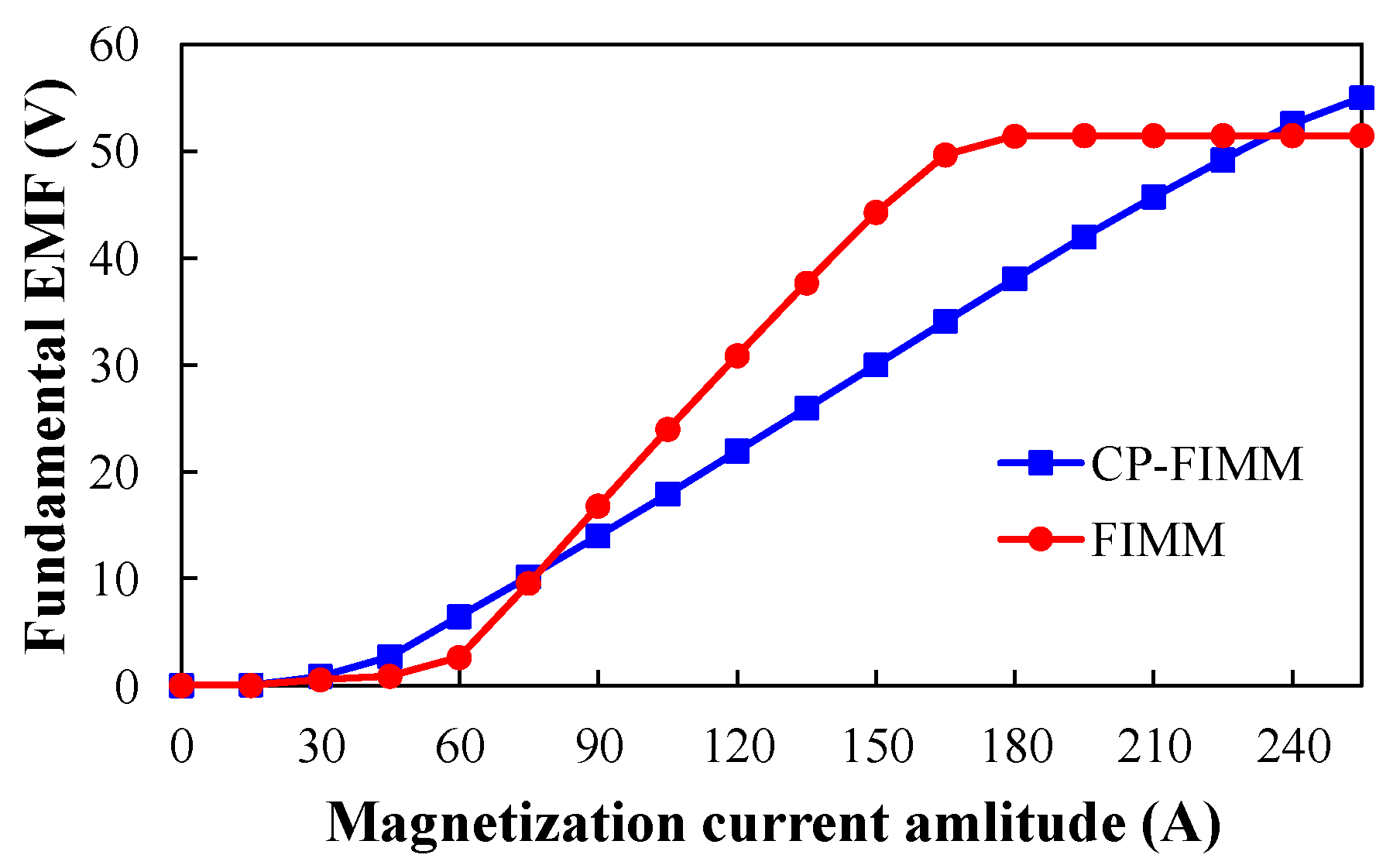
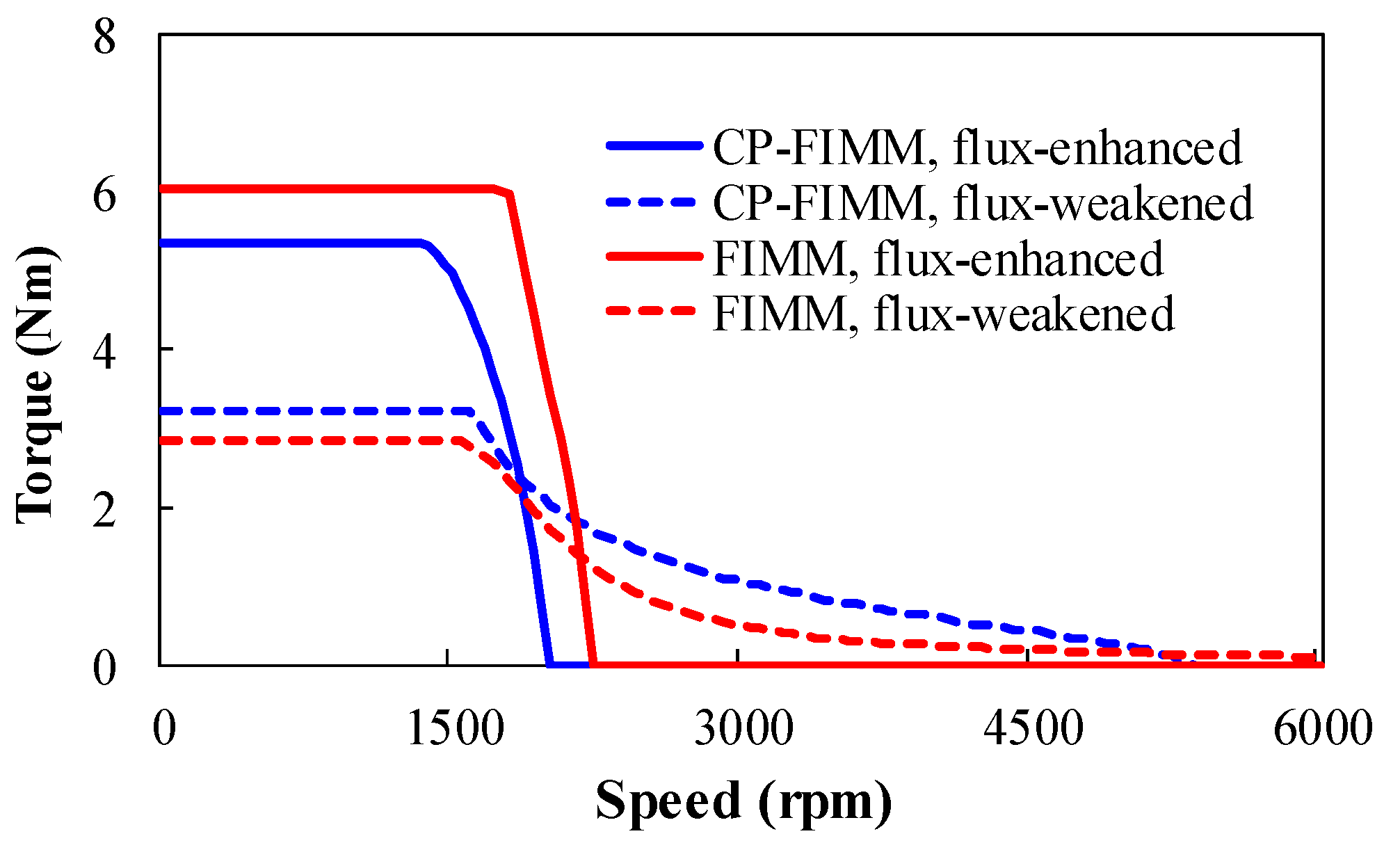
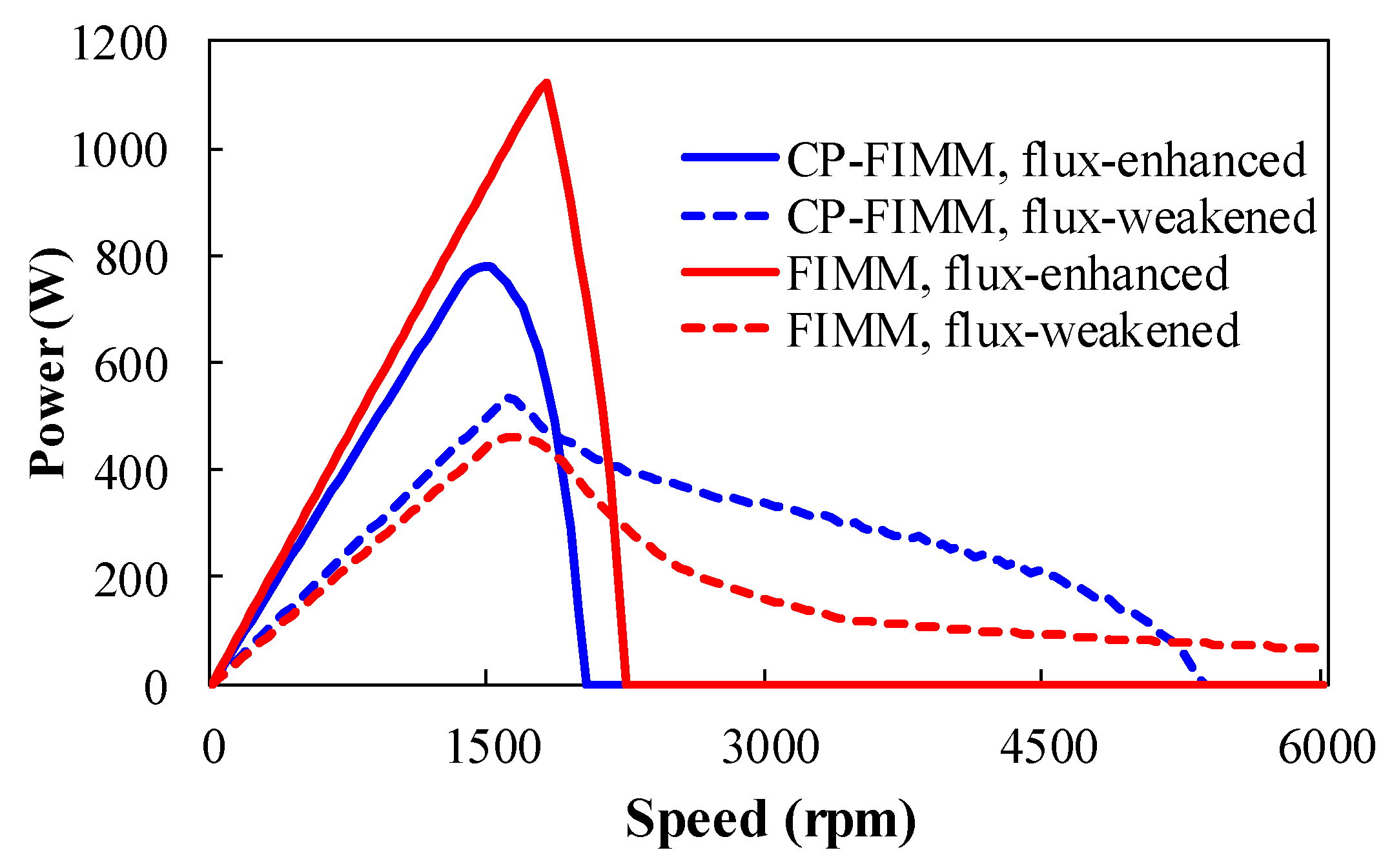
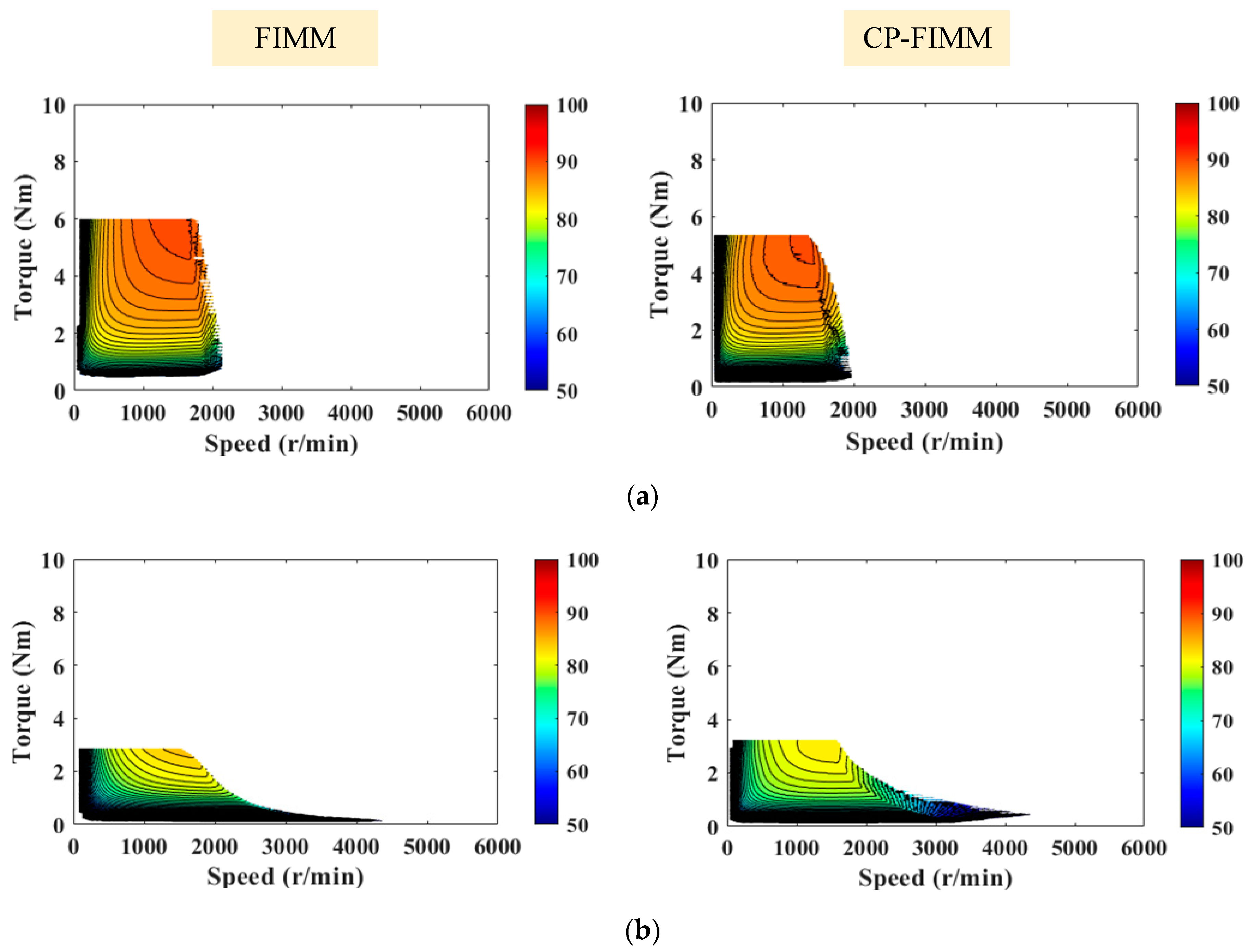
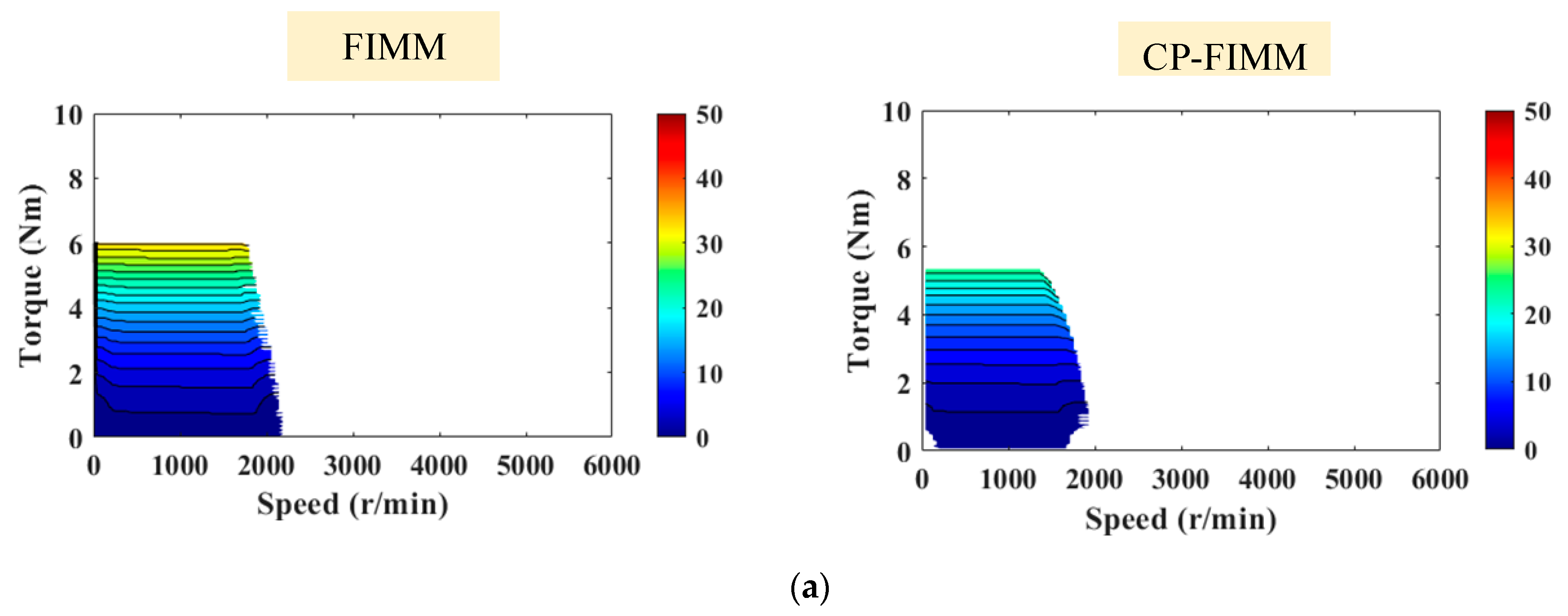



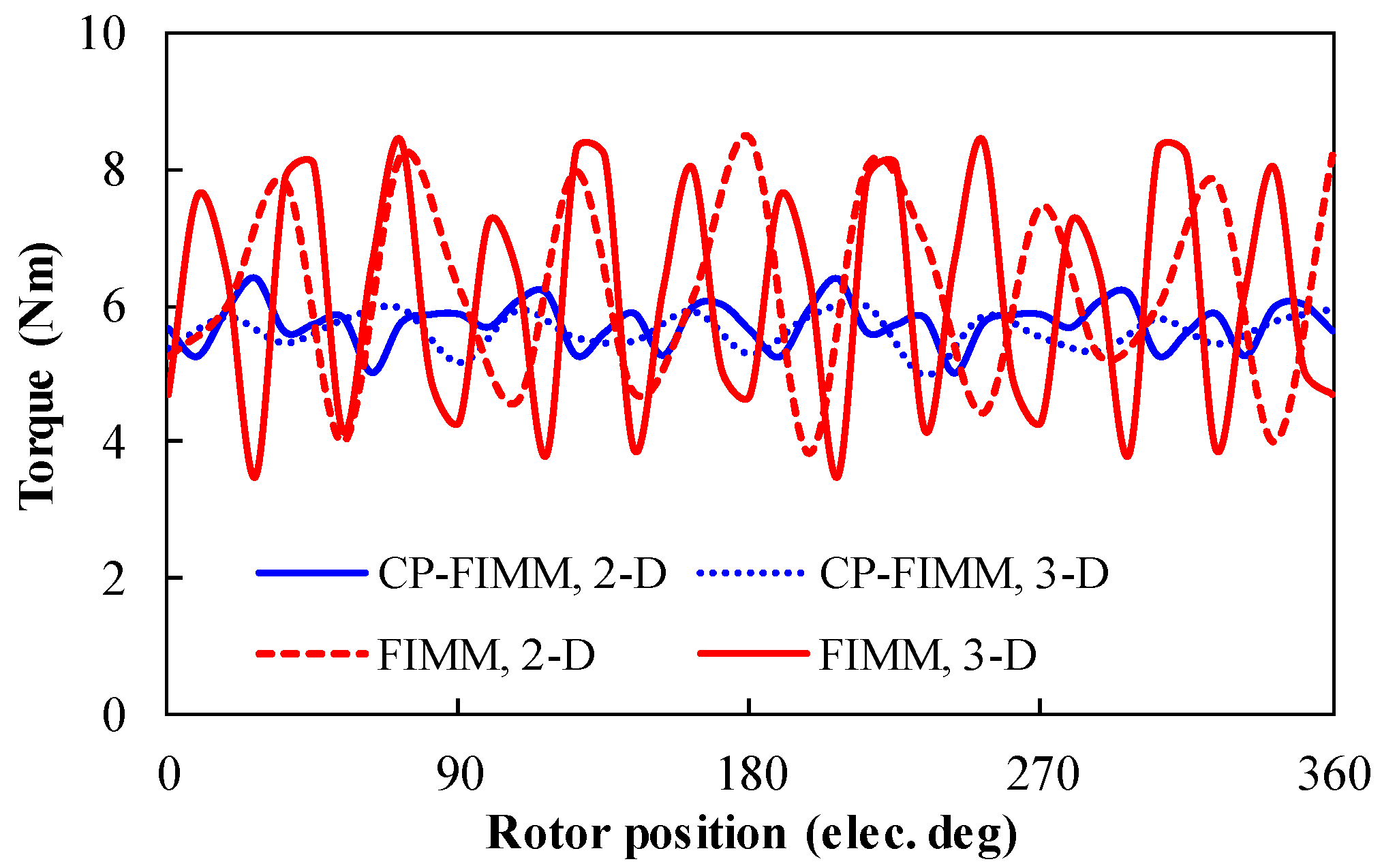
| Items | FIMM | CP-FIMM |
|---|---|---|
| Rated power (W) | 600 | |
| Rated speed (rpm) | 1000 | |
| Outer diameter of stator (mm) | 122 | |
| Inner diameter of stator (mm) | 75 | |
| Air-gap length (mm) | 0.5 | |
| Outer diameter of rotor (mm) | 74.5 | |
| Inner diameter of rotor (mm) | 36.5 | |
| Active stack length (mm) | 55 | |
| Steel grade | 50JN1000 | |
| AlNiCo PM grade | AlNiCo9 | |
| AlNiCo volume (cm3) | 66.0 | 39.6 |
| Armature winding turns per phase | 360 | |
| Rated current (Arms) | 7.5 | |
| DC-link voltage (V) | 120 | |
| Symbols | Parameters |
|---|---|
| Ry | magnetic reluctance of stator yoke |
| Rg | magnetic reluctance of air-gap |
| Rf | magnetic reluctance of iron pole |
| Rm1 | magnetic reluctance of AlNiCo in the FIMM |
| Rm2 | magnetic reluctance of AlNiCo in the CP-FIMM |
| Fm1 | magnetomotive force MMF of AlNiCo in the FIMM |
| Fm2 | magnetomotive force MMF of AlNiCo in the CP-FIMM |
| Items | FIMM | CP-FIMM |
|---|---|---|
| Average torque (Nm) | 6.54 | 5.74 |
| Torque ripple (%) | 50.18 | 23.98 |
| Cogging torque (Nm) | 1.29 | 1.34 |
| Average torque/PM volume (Nm/cm3) | 0.099 | 0.145 |
| Items | FIMM | CP-FIMM | ||
|---|---|---|---|---|
| 2-D | 3-D | 2-D | 3-D | |
| Average torque (Nm) | 6.54 | 6.25 | 5.74 | 5.98 |
| Torque ripple (%) | 50.18 | 63.50 | 23.98 | 17.65 |
Publisher’s Note: MDPI stays neutral with regard to jurisdictional claims in published maps and institutional affiliations. |
© 2022 by the authors. Licensee MDPI, Basel, Switzerland. This article is an open access article distributed under the terms and conditions of the Creative Commons Attribution (CC BY) license (https://creativecommons.org/licenses/by/4.0/).
Share and Cite
Tu, R.; Yang, H.; Lin, H.; Zhan, H.; Wu, D.; Yu, M.; Chen, L.; Chen, W. Investigation of a Novel Consequent-Pole Flux-Intensifying Memory Machine. Energies 2022, 15, 5501. https://doi.org/10.3390/en15155501
Tu R, Yang H, Lin H, Zhan H, Wu D, Yu M, Chen L, Chen W. Investigation of a Novel Consequent-Pole Flux-Intensifying Memory Machine. Energies. 2022; 15(15):5501. https://doi.org/10.3390/en15155501
Chicago/Turabian StyleTu, Rui, Hui Yang, Heyun Lin, Hanlin Zhan, Di Wu, Minghu Yu, Liang Chen, and Wenjie Chen. 2022. "Investigation of a Novel Consequent-Pole Flux-Intensifying Memory Machine" Energies 15, no. 15: 5501. https://doi.org/10.3390/en15155501
APA StyleTu, R., Yang, H., Lin, H., Zhan, H., Wu, D., Yu, M., Chen, L., & Chen, W. (2022). Investigation of a Novel Consequent-Pole Flux-Intensifying Memory Machine. Energies, 15(15), 5501. https://doi.org/10.3390/en15155501






